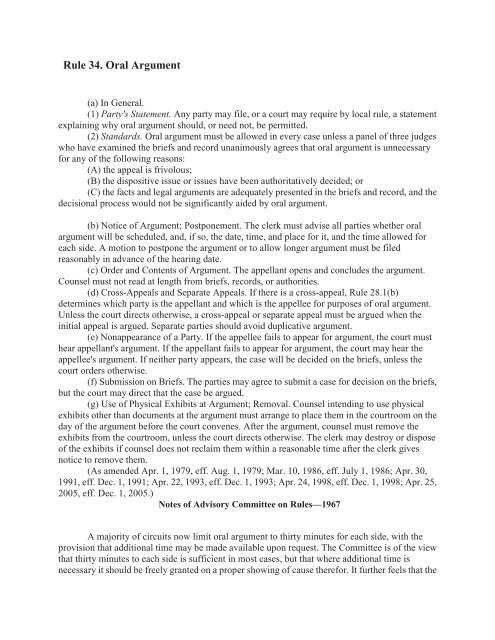Federal Rules of Appellate Procedure 2014-2015, 2014a
Federal Rules of Appellate Procedure 2014-2015, 2014a
Federal Rules of Appellate Procedure 2014-2015, 2014a
Create successful ePaper yourself
Turn your PDF publications into a flip-book with our unique Google optimized e-Paper software.
Rule 34. Oral Argument<br />
(a) In General.<br />
(1) Party's Statement. Any party may file, or a court may require by local rule, a statement<br />
explaining why oral argument should, or need not, be permitted.<br />
(2) Standards. Oral argument must be allowed in every case unless a panel <strong>of</strong> three judges<br />
who have examined the briefs and record unanimously agrees that oral argument is unnecessary<br />
for any <strong>of</strong> the following reasons:<br />
(A) the appeal is frivolous;<br />
(B) the dispositive issue or issues have been authoritatively decided; or<br />
(C) the facts and legal arguments are adequately presented in the briefs and record, and the<br />
decisional process would not be significantly aided by oral argument.<br />
(b) Notice <strong>of</strong> Argument; Postponement. The clerk must advise all parties whether oral<br />
argument will be scheduled, and, if so, the date, time, and place for it, and the time allowed for<br />
each side. A motion to postpone the argument or to allow longer argument must be filed<br />
reasonably in advance <strong>of</strong> the hearing date.<br />
(c) Order and Contents <strong>of</strong> Argument. The appellant opens and concludes the argument.<br />
Counsel must not read at length from briefs, records, or authorities.<br />
(d) Cross-Appeals and Separate Appeals. If there is a cross-appeal, Rule 28.1(b)<br />
determines which party is the appellant and which is the appellee for purposes <strong>of</strong> oral argument.<br />
Unless the court directs otherwise, a cross-appeal or separate appeal must be argued when the<br />
initial appeal is argued. Separate parties should avoid duplicative argument.<br />
(e) Nonappearance <strong>of</strong> a Party. If the appellee fails to appear for argument, the court must<br />
hear appellant's argument. If the appellant fails to appear for argument, the court may hear the<br />
appellee's argument. If neither party appears, the case will be decided on the briefs, unless the<br />
court orders otherwise.<br />
(f) Submission on Briefs. The parties may agree to submit a case for decision on the briefs,<br />
but the court may direct that the case be argued.<br />
(g) Use <strong>of</strong> Physical Exhibits at Argument; Removal. Counsel intending to use physical<br />
exhibits other than documents at the argument must arrange to place them in the courtroom on the<br />
day <strong>of</strong> the argument before the court convenes. After the argument, counsel must remove the<br />
exhibits from the courtroom, unless the court directs otherwise. The clerk may destroy or dispose<br />
<strong>of</strong> the exhibits if counsel does not reclaim them within a reasonable time after the clerk gives<br />
notice to remove them.<br />
(As amended Apr. 1, 1979, eff. Aug. 1, 1979; Mar. 10, 1986, eff. July 1, 1986; Apr. 30,<br />
1991, eff. Dec. 1, 1991; Apr. 22, 1993, eff. Dec. 1, 1993; Apr. 24, 1998, eff. Dec. 1, 1998; Apr. 25,<br />
2005, eff. Dec. 1, 2005.)<br />
Notes <strong>of</strong> Advisory Committee on <strong>Rules</strong>—1967<br />
A majority <strong>of</strong> circuits now limit oral argument to thirty minutes for each side, with the<br />
provision that additional time may be made available upon request. The Committee is <strong>of</strong> the view<br />
that thirty minutes to each side is sufficient in most cases, but that where additional time is<br />
necessary it should be freely granted on a proper showing <strong>of</strong> cause therefor. It further feels that the


















